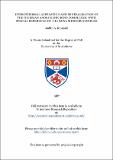Hydrothermal alteration and mineralisation of the Nigerian anorogenic ring complexes: with special reference to the Saiya Shokobo complex
Abstract
The Nigerian anorogenic province is characterised by more than 50 complexes. In some complexes, the outer limits of the complexes are defined partly or completely by a ring dyke. This intrusion, generally composed of granite porphyry, was the chief structural element of the complex and controlled the distribution of both volcanic and subvolcanic magmatism at high levels in the crust. The complexes are exposed at different erosional levels: in some complexes, particularly in the north, the volcanic products are preserved through caldera collapse. The majority of the volcanics are dominantly rhyolitic, some alkaline centres have preserved occasional successions of hawaiites, mugearites and trachytes confirming the dominantly alkaline trend from transitional ne-normative or ne-normative basalts. In other centres the volcanic cover has been removed so that the subvolcanic granites and syenites have been exposed. The subvolcanic assemblages include minor gabbros, monzogabbros and syenites. However granitic rocks are overwhelmingly dominant with fayalite hedenbergite granites, amphibole granites and syenites, albite-rich and albite-poor aegirine arfvedsonite granites and biotite granites. As far as the granites are concerned there was a natural progression from volcanic feeder intrusions to subvolcanic intrusions with fayalite and hedenbergite. The volcanic feeder intrusions were an important link during the caldera-forming stage between the subvolcanic roots and the overlying volcanic pile. They are represented by quartz and granite porphyries. The mineralogical assemblages of many of these complexes however, is often the result of interaction with residual fluids. Fluids affected the late magmatic and particularly the postmagnatic (subsolidus) crystallisation history of a cooling subvolcanic pluton and to some extent the overlying volcanic pile. Such hydrothermal alteration has undoubtedly modified the original granite chemistry. The residual fluids which were responsible for hydrothermal alteration also carried ore metals which were variously deposited at different stages of hydrothermal alteration. Mineralisation of a pluton generally occurred in the apical or marginal zones or in satellite dykes. Different styles of mineralisation tend to characterise different parts of a granite pluton and five separate zones have been recognised; the roof, marginal and contact zones of a pluton, the enclosing or overlying rocks and the surrounding ring dyke. Nine different styles of mineralisation have been identified including pervasive metasomatic disseminations; pegmatitic pods and lenses; stockworks and lodes. No particular type of hydrothermal alteration is restricted to one particular style of mineralisation and it is possible to have disseminated sodic, potassic, acid or silica metasomatism and altered ring dykes may show the effects of all these processes. The complexity of the subsolidus mineralogical re-equilibration has been appreciated by a detailed study of the Rishi area of the Saiya Shokobo caiplex. The Saiya Shokobo complex forms a distinctive hill mass in north central Nigeria which covers an area of approximately 250km. The main structural feature of the complex is the elliptical fracture 17km in diameter which has largely determined the outline of the central massif of the Saiya Shokobo Hills and has controlled the emplacement of several of the intrusions of the complex. The complex is dominated by volcanic rocks which are confined within this elliptical fracture. During the latest stage of magmatic activity, the emplacement of a granite pluton moved beyond the confines of the main fracture and was intruded eccentrically to the north east of the main part of the complex. Thus the biotite granite intruded both its own volcanic pile and the basement hornblende biotite monzogranite.
Type
Thesis, PhD Doctor of Philosophy
Collections
Items in the St Andrews Research Repository are protected by copyright, with all rights reserved, unless otherwise indicated.

